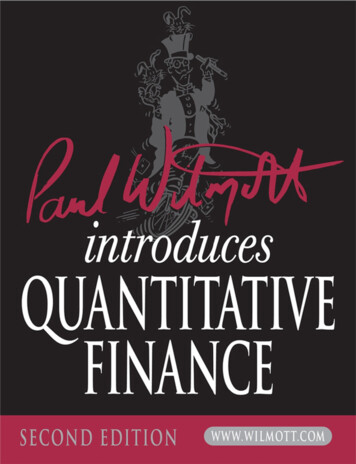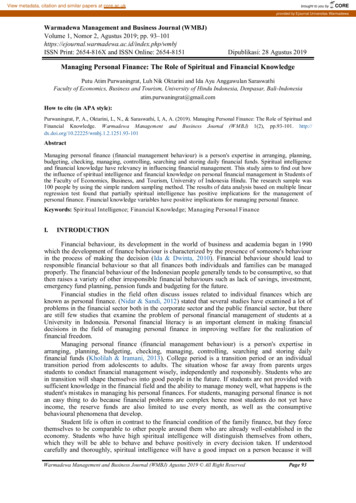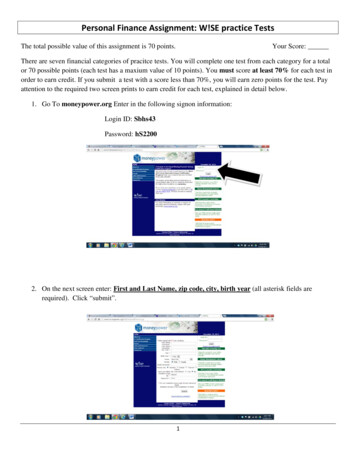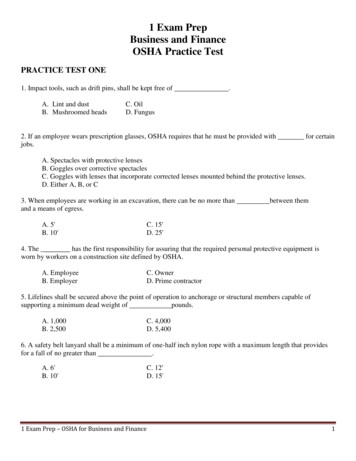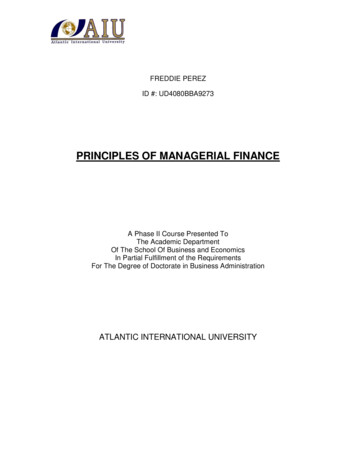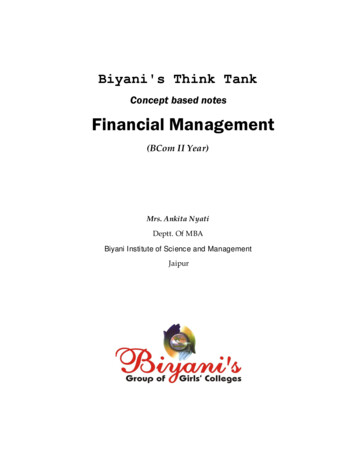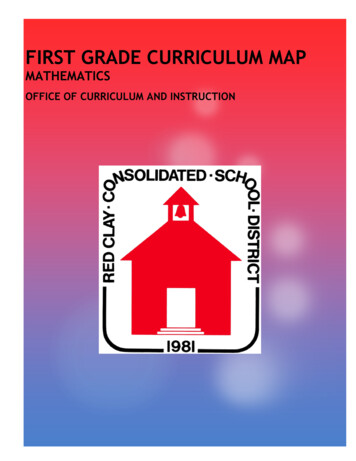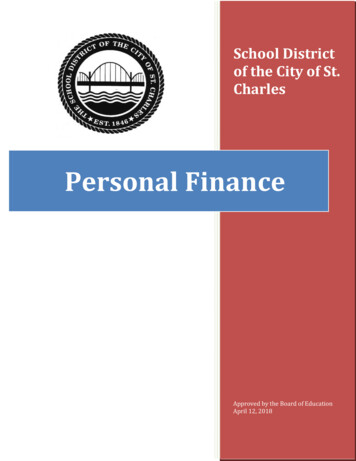
Transcription
School Districtof the City of St.CharlesPersonal FinanceApproved by the Board of EducationApril 12, 20181
9-12 Personal Finance Curriculum CommitteeCurriculum Committee ChairpersonTina Lauer, Administration Building, Instructional Technology SpecialistCurriculum DevelopersPatrick Gebhard, St. Charles High SchoolPam Meyer, Success CampusRobyn McLaughlin, St. Charles West High School2
9-12 Personal Finance CurriculumTABLE OF CONTENTSTable of Contents .3District Mission Statement 4District Vision 4District Values 4District Goals . .5Philosophical Foundations .5Personal Finance Philosophy 6Personal Finance Course Description .6Personal Finance Rationale 6Personal Finance Program Goals .6Personal Finance Essential Learner Outcomes .7Personal Finance Curriculum .8Appendix - Course Level Expectations (Missouri Learning Standards) .593
District MissionThe City of St. Charles School District will REACH, TEACH, and EMPOWER all students by providinga challenging, diverse, and innovative education.District VisionThe City of St. Charles School District will be an educational leader recognized for high performanceand academic excellence that prepares students to succeed in an ever-changing global society.District ValuesWe, the City of St. Charles School District community of students, parents, staff, and patrons, value: High quality education for all students which includes:Lifelong learning from early childhood through adult educationRigorous learning experiences that challenge all studentsInstruction that meets the needs of a diverse communityRespect for allReal world, critical thinking and problem-solving skills to prepare students for the 21stCentury Developing caring, productive, and responsible citizens Strong engagement of family and community A safe, secure, and nurturing school environment Achievement through: Celebration of individual successCollaboration with parents and community stakeholdersExploration, Innovation, and creativity High quality staff by: Hiring and retaining highly qualified and invested employeesProviding professional development and collaboration focused on increasing studentachievementEmpowering staff to use innovative resources and practices Informed decisions that are: Student-centeredFocused on student achievementData DrivenConsiderate of all points of viewFiscally responsible4
District GoalsFor planning purposes, five overarching goals have been developed. These goals are statements ofthe key functions of the school district.1. Student Performance Develop and enhance the quality educational/instructional programs to improve studentperformance and enable students to meet their personal, academic, and career goals.2. Highly qualified staff Recruit, attract, develop, and retain highly qualified staff to carry out the District’smission, vision, goals, and objectives.3. Facilities, Support, and Instructional Resource Provide and maintain appropriate instructional resources, support services, andfunctional and safe facilities.4. Parent and Community Involvement Promote, facilitate and enhance parent, student, and community involvement in districteducational programs.5. Governance Govern the district in an efficient and effective manner providing leadership andrepresentation to benefit the students, staff, and patrons of the district.School District Philosophical FoundationsTeachers in the School District of the City of St. Charles share in and ascribe to a philosophy thatplaces children at the heart of the educational process. We feel that it is our professionalresponsibility to strive to be our best at all times and to maximize our efforts by ensuring that thefollowing factors are present in our classrooms and our schools.1. Learning is developed within the personal, physical, social, and intellectual contexts of thelearner.2. A strong educational program should provide developmental continuity.3. The successful learner is motivated, strategic, knowledgeable, and interactive.4. Children learn best when they have real purposes and can make connections to real life.5. Effective learning is a combination of student exploration and teacher and mentor modeling.6. Assessment is an ongoing and multidimensional process that is an integral part ofinstruction.7. Making reading and writing connections across multiple sources and curricula facilitatesmeaning.8. Literacy for the future means literacy in multiple technologies.9. Education must respond to society’s diverse population and serve all children.10. Interactions among students, teachers, parents, and community form the network thatsupports learning.5
9-12 Personal Finance PhilosophyThe philosophy of Personal Finance is to help students to become financially responsible andconscientious members of society, to reach that end, this course develops students’ understandingand skills in such areas as money management, budgeting, financial goal attainment, income andcareers, the wise use of credit and debt management, becoming a critical consumer, insurance,investments, and savings.9-12 Personal Finance Course DescriptionUnderstanding and managing personal finances are key to one’s future financial success. This onesemester course is based on the Missouri Personal Finance Competencies and presents essentialknowledge and skills to make informed decisions about real world financial issues. Students willlearn how choices influence occupational options and future earning potential. Students will alsolearn to apply decision-making skills to evaluate career choices and set personal goals. The coursecontent is designed to help the learner make wise spending, saving, and credit decisions and tomake effective use of income to achieve personal financial success.9-12 Personal Finance RationaleFinancial literacy is essential in meeting the financial challenges of the 21st Century. Thecompetencies which form the basis for this semester course enable students to analyze theirpersonal financial decisions, evaluate the costs and benefits of their decisions, recognize theirrights and responsibilities as consumers, and apply the knowledge learned in school to financialsituations encountered later in life.9-12 Personal Finance Program GoaIsGraduates from this course will be able to:1. Explain financial literacy and how sound financial decisions can increase a person’sstandard of living and wealth.2. Develop a career path based on rational decision making, appropriate research and selfreflection.3. Apply decision making to personal financial choices (planning, maintaining and analyzingmoney management) throughout various stages of financial status.4. Evaluate the sources and resources of financial systems that are available throughoutvarious stages of financial status.5. Evaluate sources of credit, as well as the rights and responsibilities of credit, and be able toapply a decision-making process to ensure appropriate purchases.6. Evaluate investments and create a plan for the future.7. Apply the rights and responsibilities of consumers to personal living and financial choices.6
9-12 Personal Finance Enduring Understandings/Learner Outcomes1.2.3.4.5.People can increase income and job opportunity by acquiring more education and skillsPeople receive compensation in various formsPeople have taxes and other deductions taken from their incomePeople can create a budget to differentiate between income and expensesPeople should create a budget that includes housing and transportation, being prepared foremergencies, and savings.6. People can identify alternative payment methods7. People can use various institutions for financial needs8. People have unlimited wants, but limited resources9. People have financial choices and decisions to make daily10. People can create a budget to differentiate between income and expenses11. People should create a budget that includes housing and transportation, being prepared foremergencies, and savings.12. People can identify alternative payment methods13. People can use various institutions for financial needs14. People’s savings are affected by time, interest rates, and inflation.15. People choose among different credit options that have different costs.16. Credit choices will impact the value of your financial future.17. People can choose to accept risk, reduce risk, or share the risk with others.18. Insurance allows people to transfer risk by paying a fee now to avoid the possibility of alarger loss later.19. The price of insurance is influenced by an individual’s circumstances and behavior.20. Investors choose among investments that have different risks and expected rates of return.21. Investments with higher expected rates of return tend to have greater risk.22. Diversification of investment among several choices can lower investment risk.7
CONTENT AREA: Personal FinanceUNIT TITLE: Financial Decision Making (Strand 1)COURSE/Grade Level: Personal Finance/High SchoolUNIT DURATION: 2 weeksMATERIALS / INSTRUCTIONAL RESOURCES FOR THIS UNIT: Managing Your Personal Finances (7th edition)-Cengage Managing Your Personal Finances: Student Activity Guide-Cengage https://nefe.org/ https://www.econedlink.org https://www.stlouisfed.org/education EverFi - Financial Literacy https://platform.everfi.net/registration/login e/view cy-q1/view cy-q2/viewENDURING UNDERSTANDINGS: People have unlimited wants, but limited resources People have financial choices and decisions to make dailyBIG IDEA(S): Choice is the central principle of financial decision-making forindividuals, businesses, and government.ESSENTIAL QUESTIONS: How is the cost of something determined? What is the relationship between choice and opportunity cost? How can an individual make an informed and researched financialdecision?WHAT SHOULD STUDENTS KNOW, UNDERSTAND, AND BE ABLE TO DO AT THE END OF THIS UNIT?Standards, Concepts, Content, Skills, Products, DS: Content specific standards that will be addressed in this unit.STANDARDSTANDARDi.e. GLE/CLE/MLS/ISTEMLS I.1A Unlimited Wants andEvaluate the role of choice in decision-making.XLimited ResourcesMLS I.1B Unlimited Wants and Limited Apply a rational decision-making process.XResourcesMLS I.2A Choice and Decision-Making Explain how today’s choices have future consequences.XMLS I.2B Choice and Decision-Making Explain the casual relationship between choice and opportunity cost.XMLS I.2C Choice and Decision-Making Analyze how choices can result in unintended consequences.X8
OBJECTIVE # 1REFERENCES/STANDARDSThe students will understand that people have unlimited wants but have limited resources. MLS I.1.A&BWHAT SHOULD STUDENTS KNOW?Facts, Names, Dates, Places, Information,ACADEMIC VOCABULARY Opportunity cost, scarcity, values,wants, needsUNDERSTAND?BE ABLE TO DO?Concepts; essential truths that give meaning to theSkills; Productstopic; ideas that transfer across situations. Students will understand that choices The student will be able to use a decisionmust be made based on availablemaking model to determine the best choiceresources.available.FACILITATING ACTIVITIES – STRATEGIES AND METHODS FOR TEACHING AND LEARNINGTEACHER INSTRUCTIONAL ACTIVITYSTUDENT LEARNING TASKDOK TARGET(1 Recall, 2 Skill/Concept, 3 Strategic Thinking,4 Extended Thinking)2 Opportunity Cost activity Worksheet2 Scarcity activity Vocabulary assignment3/4 Decision-making process Complete decision-making model2 Wants vs. needs activity worksheet INTERDISCIPLINARY CONNECTIONMathematics, economics, computer skills CAREER CONNECTIONAll jobs require decision-makingHOW DO WE KNOW WHAT STUDENTS HAVE LEARNED?ASSESSMENT DESCRIPTIONFORMATIVEDOK TARGETOR(1 Recall, 2 Skill/Concept, 3 Strategic Thinking,SUMMATIVE?4 Extended Thinking)Formative3Opportunity costFormative3Decision-makingSummative3/4Unit test9
HOW WILL WE RESPOND IF STUDENTS HAVE NOT LEARNED?Possible InterventionsINSTRUCTIONAL ACTIVITY/METHODSTUDENT LEARNING TASKDOK TARGET(1 Recall, 2 Skill/Concept, 3 Strategic Thinking,4 Extended Thinking)2/3 Academic Intervention Period Remediation and retestingHOW WILL WE RESPOND IF STUDENTS HAVE ALREADY LEARNED?Possible Extensions/EnrichmentsINSTRUCTIONAL ACTIVITY/METHODSTUDENT LEARNING TASKDOK TARGET(1 Recall, 2 Skill/Concept, 3 Strategic Thinking,4 Extended Thinking)4 Community issue or event Using decision-making model to fix aproblem in the communityOBJECTIVE # 2The students will understand that choices must be made through a decision-making process.REFERENCES/STANDARDS MLS I.2.A, B, & CUNDERSTAND?Concepts; essential truths that give meaning to thetopic; ideas that transfer across situations. Students will understand how today’schoices have future consequencesWHAT SHOULD STUDENTS KNOW?Facts, Names, Dates, Places, Information,ACADEMIC VOCABULARY Goal setting, opportunity cost, values,wants, needs.BE ABLE TO DO?Skills; Products The students will be able to create a goalusing the SMART goal format.FACILITATING ACTIVITIES – STRATEGIES AND METHODS FOR TEACHING AND LEARNINGTEACHER INSTRUCTIONAL ACTIVITYSTUDENT LEARNING TASKDOK TARGET(1 Recall, 2 Skill/Concept, 3 StrategicThinking, 4 Extended Thinking)2/3 SMART goal activity Create a SMART goalINTERDISCIPLINARY CONNECTION Mathematics, computers CAREER CONNECTIONAll careers need to make decisions10
HOW DO WE KNOW WHAT STUDENTS HAVE LEARNED?ASSESSMENT DESCRIPTIONFORMATIVE ORSUMMATIVE? Decision-making quizUnit testFormativeSummative2/33/4HOW WILL WE RESPOND IF STUDENTS HAVE NOT LEARNED?Possible InterventionsTEACHER INSTRUCTIONAL ACTIVITYSTUDENT LEARNING TASK Academic Intervention Period Remediation and retestingDOK TARGET(1 Recall, 2 Skill/Concept, 3 StrategicThinking, 4 Extended Thinking)DOK TARGET(1 Recall, 2 Skill/Concept, 3 StrategicThinking, 4 Extended Thinking)2/3HOW WILL WE RESPOND IF STUDENTS HAVE ALREADY LEARNED?Possible Extensions/EnrichmentsINSTRUCTIONAL ACTIVITY/METHODSTUDENT LEARNING TASKDOK TARGET(1 Recall, 2 Skill/Concept, 3 StrategicThinking, 4 Extended Thinking)4 Community issue or event Using decision-making model to fix aproblem in the community11
Proficiency Scales – Strand 1Strand 1: Financial Decision MakingTopic/Objective: The students will understand that people have unlimited wants but have limited resources.Course/Grade Level: Personal Finance - High SchoolScore4.03.5Score3.0In addition to Score 3.0, in-depth inferences and applications that gobeyond what was taught. Community issue or eventIn addition to score 3.0 performance, in-depth inferences and applicationswith partial success.The student will be able to: 2.5Score2.01.5Score1.0Score0.0The student will be able to use a decision-making model todetermine the best choice available.No major errors or omissions regarding 2.0 content and partial knowledgeof the 3.0 contentThere are no major errors or omissions regarding the simpler detailsand processes as the student: recognizes or recalls specific terminology such as:o Opportunity cost, scarcity, values, wants, needs performs basic processes, such as:o Worksheet and vocabulary assignmentSample Tasks Using decision-making model to fix a problemin the community Complete decision-making modelOnline activities Worksheet and vocabulary assignmentHowever, the student exhibits major errors or omissions regardingthe more complex ideas and processes.Partial knowledge of the 2.0 content but major errors or omissionsregarding the 3.0 contentWith help, a partial understanding of some of the simpler details andprocesses and some of the more complex ideas and processes.Even with help, no understanding or skill demonstrated.12
Strand 1: Financial Decision MakingTopic/Objective: The students will understand that choices must be made through a decision-making process.Course/Grade Level: Personal Finance - High SchoolScore4.03.5Score3.0In addition to Score 3.0, in-depth inferences and applicationsthat go beyond what was taught. Community issue or eventIn addition to score 3.0 performance, in-depth inferences andapplications with partial success.The student will be able to: 2.5Score2.01.5Score1.0Score0.0Sample Tasks Using decision-making model to fix a problem in thecommunity Create a SMART goal Vocabulary assignmentThe students will be able to create a goal using the SMARTgoal format.No major errors or omissions regarding 2.0 content and partialknowledge of the 3.0 contentThere are no major errors or omissions regarding the simplerdetails and processes as the student: recognizes or recalls specific terminology such as:o Goal setting, opportunity cost, values, wants, needs. performs basic processes, such as:o Vocabulary assignmentHowever, the student exhibits major errors or omissionsregarding the more complex ideas and processes.Partial knowledge of the 2.0 content but major errors or omissionsregarding the 3.0 contentWith help, a partial understanding of some of the simplerdetails and processes and some of the more complex ideas andprocesses.Even with help, no understanding or skill demonstrated.13
CONTENT AREA: Personal FinanceUNIT TITLE: Earning Income (Strand 2)COURSE/Grade Level: Personal Finance/High SchoolUNIT DURATION: 3 weeksMATERIALS / INSTRUCTIONAL RESOURCES FOR THIS UNIT: Managing Your Personal Finances (7th edition)-Cengage Managing Your Personal Finances: Student Activity Guide-Cengage https://nefe.org/ https://www.econedlink.org https://www.stlouisfed.org/education https://portal.missouriconnections.org/ https://www.irs.gov/ http://dor.mo.gov/ EverFi - Financial Literacy https://platform.everfi.net/registration/login e/view heckcurriculum-unit cy-q1/view cy-q2/viewENDURING UNDERSTANDINGS: People can increase income and job opportunity by acquiring moreeducation and skills People receive compensation in various forms People have taxes and other deductions taken from their incomeBIG IDEA(S): Income is determined by work ethic, education, and market value oflabor paid as wages and salariesESSENTIAL QUESTIONS: How does education and skill development affect earning potential? How does career choice impact career earning and quality of life? How do employer and government deductions (insurance, taxes, SS,etc.) affect net income? How does an individual complete tax and employment forms?WHAT SHOULD STUDENTS KNOW, UNDERSTAND, AND BE ABLE TO DO AT THE END OF THIS UNIT?Standards, Concepts, Content, Skills, Products, DS: Content specific standards that will be addressed in this unit.STANDARDSTANDARDi.e. GLE/CLE/MLS/ISTEMLS II.1 A Career Choices andEvaluate how career choices impact income and quality of life.XConsequencesMLS II.1 B Career Choices andAnalyze the relationship between education, skill development, and earningX14
ConsequencesMLS II.1 C Career Choices andConsequencesMLS II.1 D Career Choices andConsequencesMLS II.1 E Career Choices andConsequencesMLS II.2 A Forms of CompensationMLS II.2 B Forms of CompensationMLS II.2 C Forms of CompensationMLS II.3.A Taxes and OtherDeductionsMLS II.3.B Taxes and OtherDeductionsMLS II.3.C Taxes and OtherDeductionsOBJECTIVE # 1REFERENCES/STANDARDSpotential.Describe how wages and salaries are determined in labor markets.XAnalyze how changes in economic conditions and/or in labor markets can causechanges in a person’s income or employment status.Describe how entrepreneurs see problems as opportunities for creating new orinnovative goods or services.Examine how workers are paid through wages, salaries and commissionsAnalyze why benefits such as health insurance, paid vacation, retirement plan, familyleave, tuition reimbursement and flexible spending are considered forms ofcompensation.Identify sources for earning income in addition to wages and salaries such as rent,interest, gifts, dividends, profits and capital gains.Compare gross and net incomeXExplain the purpose of standard deductions such as income taxes, social security(FICA), Medicare, deductions for health care and retirement savings plansExplain how taxes provide public goods and services.XXXXXXXThe students will understand that there are many career choices. MLS II.1.A, B, C, D, EUNDERSTAND?Concepts; essential truths that give meaning to thetopic; ideas that transfer across situations. Student will evaluate how career choiceimpacts income and quality and life.WHAT SHOULD STUDENTS KNOW?Facts, Names, Dates, Places, Information,ACADEMIC VOCABULARY Wages, salary, compensation,entrepreneur.BE ABLE TO DO?Skills; ProductsThe student will be able to research careerinterest inventory and potential incomelevels.FACILITATING ACTIVITIES – STRATEGIES AND METHODS FOR TEACHING AND LEARNINGTEACHER INSTRUCTIONAL ACTIVITYSTUDENT LEARNING TASKDOK TARGET(1 Recall, 2 Skill/Concept, 3 Strategic Thinking,4 Extended Thinking) Educational research Internet search2 Career research Internet search2 Career interest/skills survey Online survey2 15
INTERDISCIPLINARY CONNECTION Computers CAREER CONNECTIONAll careers earn income.HOW DO WE KNOW WHAT STUDENTS HAVE LEARNED?ASSESSMENT DESCRIPTIONFORMATIVEDOK TARGETOR(1 Recall, 2 Skill/Concept, 3 Strategic Thinking,SUMMATIVE?4 Extended Thinking)Summative3/4 Presentation on education and career choiceHOW WILL WE RESPOND IF STUDENTS HAVE NOT LEARNED?Possible InterventionsINSTRUCTIONAL ACTIVITY/METHODSTUDENT LEARNING TASKDOK TARGET(1 Recall, 2 Skill/Concept, 3 Strategic Thinking,4 Extended Thinking)2/3 Academic Instruction Period Remediation and reteachingHOW WILL WE RESPOND IF STUDENTS HAVE ALREADY LEARNED?Possible Extensions/EnrichmentsINSTRUCTIONAL ACTIVITY/METHODSTUDENT LEARNING TASKDOK TARGET(1 Recall, 2 Skill/Concept, 3 Strategic Thinking,4 Extended Thinking)4 Investigate post-high school training Research scholarship and grant Research employment options andopportunities4internships Application and interview practice16
OBJECTIVE # 2REFERENCES/STANDARDSStudents will understand compensation and deductions in regards to employment. MLS II.2.A,B,C and MLS II.3.A, B, CUNDERSTAND?Concepts; essential truths that give meaning to thetopic; ideas that transfer across situations. Student will understand different variousforms of compensation Student will understand how variousdeductions affect net payWHAT SHOULD STUDENTS KNOW?Facts, Names, Dates, Places, Information,ACADEMIC VOCABULARY Wages, salaries, commission, retirementplan, benefits, dividends, profits, SocialSecurity, Medicare, FICA, W-2,withholdings,BE ABLE TO DO?Skills; Products The students will be able to calculate netpay.FACILITATING ACTIVITIES – STRATEGIES AND METHODS FOR TEACHING AND LEARNINGTEACHER INSTRUCTIONAL ACTIVITYSTUDENT LEARNING TASKDOK TARGET(1 Recall, 2 Skill/Concept, 3 Strategic Thinking,4 Extended Thinking) worksheet2 Pay stub Tax forms2 W-2 and W-4 Online tax form2 Tax returnINTERDISCIPLINARY CONNECTIONCAREER CONNECTION Accountant, tax professional Mathematics, computers TestHOW DO WE KNOW WHAT STUDENTS HAVE LEARNED?ASSESSMENT DESCRIPTIONFORMATIVE ORDOK TARGETSUMMATIVE?(1 Recall, 2 Skill/Concept, 3 Strategic Thinking,4 Extended Thinking)Summative2/317
HOW WILL WE RESPOND IF STUDENTS HAVE NOT LEARNED?Possible InterventionsTEACHER INSTRUCTIONAL ACTIVITYSTUDENT LEARNING TASKDOK TARGET(1 Recall, 2 Skill/Concept, 3 Strategic Thinking,4 Extended Thinking)2/3 Academic Intervention Period Remediation and reteachingHOW WILL WE RESPOND IF STUDENTS HAVE ALREADY LEARNED?Possible Extensions/EnrichmentsINSTRUCTIONAL ACTIVITY/METHODSTUDENT LEARNING TASKDOK TARGET(1 Recall, 2 Skill/Concept, 3 Strategic Thinking,4 Extended Thinking)4 Research deductions on different tax Compare and contrast different taxbracketsreturns.18
Proficiency Scales – Strand 2Strand 2: Earning IncomeTopic/Objective: The students will understand that there are many career choices.Course/Grade Level: Personal Finance - High SchoolScore4.0In addition to Score 3.0, in-depth inferences and applications thatgo beyond what was taught.3.5Score3.0 Investigate post-high school trainingIn addition to score 3.0 performance, in-depth inferences andapplications with partial success.The student will be able to:Sample Tasks Research scholarship and grant opportunities Presentation on education and career choice Educational researchCareer researchCareer interest/skills survey 2.5Score2.01.5Score1.0Score0.0The student will be able to research career interest inventoryand potential income levels.No major errors or omissions regarding 2.0 content and partialknowledge of the 3.0 contentThere are no major errors or omissions regarding the simplerdetails and processes as the student: recognizes or recalls specific terminology such as:o Wages, salary, compensation, entrepreneur. performs basic processes, such as:o Online research, Career interest/skills surveyHowever, the student exhibits major errors or omissions regardingthe more complex ideas and processes.Partial knowledge of the 2.0 content but major errors or omissionsregarding the 3.0 contentWith help, a partial understanding of some of the simpler detailsand processes and some of the more complex ideas and processes.Even with help, no understanding or skill demonstrated.19
Strand 2: Earning IncomeTopic/Objective: Students will understand compensation and deductions in regards to employment.Course/Grade Level: Personal Finance - High SchoolScore4.03.5Score3.0In addition to Score 3.0, in-depth inferences and applications that gobeyond what was taught. Research deductions on different tax bracketsIn addition to score 3.0 performance, in-depth inferences andapplications with partial success.The student will be able to: 2.5Score2.0 Compare and contrast different tax returns. Paycheck activity to calculate deductionsimpact on net pay Sample tax form activitiesVocabulary activityThe students will be able to calculate net pay.No major errors or omissions regarding 2.0 content and partialknowledge of the 3.0 contentThere are no major errors or omissions regarding the simplerdetails and processes as the student: Sample Tasksrecognizes or recalls specific terminology such as:o Wages, salaries, commission, retirement plan, benefits,dividends, profits, Social Security, Medicare, FICA, W-2,withholdings,performs basic processes, such as:o Pay stubo W-2 and W-4o Tax returnHowever, the student exhibits major errors or omissions regardingthe more complex ideas and processes.Partial knowledge of the 2.0 content but major errors or omissionsregarding the 3.0 contentWith help, a partial understanding of some of the simpler detailsand processes and some of the more complex ideas and processes.Even with help, no understanding or skill demonstrated. 1.5Score1.0Score0.020
CONTENT AREA: Personal FinanceUNIT TITLE: Buying Goods and ServicesCOURSE/Grade Level: Personal Finance/High SchoolUNIT DURATION: 3 weeksMATERIALS / INSTRUCTIONAL RESOURCES FOR THIS UNIT:BIG IDEA(S): Managing Your Personal Finances (7th edition)-Cengage Creating a budget to buy goods and services can improve economic well Managing Your Personal Finances: Student Activity Guide-Cengagebeing. https://nefe.org/ https://www.econedlink.org https://www.practicalmoneyskills.com https://www.moneyinstructor.com https://www.stlouisfed.org/education EverFi - Financial Literacy https://platform.everfi.net/registration/login e/view cyq1/view cyq2/viewENDURING UNDERSTANDINGS:ESSENTIAL QUESTIONS: People can create a budget to differentiate between income and What steps are needed to create a balanced budget?expenses What form of payment is best for certain purchases? People should create a budget that includes housing and What banking methods are best for high value purchases?transportation, being prepared for emergencies, and savings. People can identify alternative payment methods People can use various institutions for financial needsWHAT SHOULD STUDENTS KNOW, UNDERSTAND, AND BE ABLE TO DO AT THE END OF THIS UNIT?Standards, Concepts, Content, Skills, Products, DS: Content specific standards that will be addressed in thisSTANDARDSTANDARDi.e. GLE/CLE/MLS/ISTEunit.MLS III.1.A Creating a BudgetDifferentiate between income and expenses.XMLS III.1.B Creating a BudgetAnalyze spending habits to recognize current spending and saving trends.XMLS III.1.C Creating a BudgetCreate a budget that includes savings goals, emergency funds, fixed expenses,X21
MLS III.1.D Creating a BudgetMLS III.1.E Creating a BudgetMLS III.2.A Purchasing Items of High ValueMLS III.2.B Purchasing Items of High ValueMLS III.2.C Purchasing Items of High ValueMLS III.2.D Purchasing Items of High ValueMLS III.2E Purchasing Items of High ValueMLS III.3.A Considering Alternative Goodsand ServicesMLS III.3.B Considering Alternative Goodsand ServicesMLS III.4.A Selecting Financial InstitutionsMLS III.4.B Selecting Financial InstitutionsMLS III.4.C Selecting Financial InstitutionsMLS III.4.D Selecting Financial InstitutionsOBJECTIVE # 1REFERENCES/STANDARDSand variable expensesExpla
9-12 Personal Finance Course Description Understanding and managing personal finances are key to ’ . - semester course is based on the Missouri Personal Finance Competencies and presents essential knowledge and skills to make informed d


